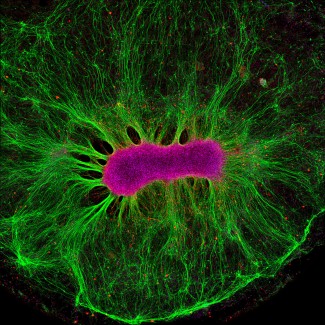Nearly half of humanity speaks more than one language, and many adults can read and master several writing systems. How does the visual cortex adapt to the recognition of words written with different characters? To answer this question, Laurent Cohen at Paris Brain Institute and the Unicog team led by Stanislas Dehaene at NeuroSpin, CEA's neuroimaging center, studied the brains of 31 bilingual people. Using high-resolution 7T fMRI, the researchers showed that the Visual Word Form Area (VWFA) is composed of tiny cortical areas sensitive to word perception. These areas are indifferently activated when reading English and French. However, in English-Chinese bilinguals, certain cortical areas react specifically to Chinese ideograms and seem involved in face recognition. Learning several writing systems could therefore shape the visual cortex to the point that certain groups of neurons specialize in reading one alphabet. These results are published in the journal Science Advances.
Like musicians who can play several instruments and read different types of musical notation, people who regularly read in two languages have developed a remarkable ability to navigate from one linguistic universe to another. This capacity is even more fascinating among those who master several writing systems: Roman, Georgian, or Hebrew alphabets, Japanese kanji, Chinese ideograms, Arabic diacritics... the world's languages each have their way of transcribing sounds and meanings. But how does this reading agility develop in the brain?
Within the left ventral occipitotemporal cortex, the recognition of written words mobilizes a specific region called the Visual Word Form Area (VWFA) formed during the acquisition of reading. It is part of a vast mosaic of visual cortex areas specialized in the visual identification of objects – such as faces, silhouettes, tools, or places. People who have this area damaged become alexic, meaning they lose the ability to recognize words or even simple letters.
Until now, this region, which is essential for reading acquisition, was relatively unknown – mainly because of the low spatial resolution of MRI scans commonly used in research. Researchers now wonder how the neural architecture of the VWFA builds under the influence of education, experience, culture, and learning.
We wanted to determine whether it is divided into smaller areas specialized in one or more languages. Is alphabetic writing processed the same way as writing based on logograms – graphic symbols representing a word?
High resolution for high literacy
To answer these questions, Laurent Cohen and Stanislas Dehaene's team conducted reading tests on 10 English-Chinese and 21 English-French bilinguals using NeuroSpin's 7T MRI, whose accuracy is far superior to that of conventional MRIs. During the MRI test, participants were asked to look at characters on a screen that may or may not form real French, Chinese, or English words, together with numbers, faces, houses, etc.
Using this protocol, the researchers were able to look at the VWFA of each participant. They found that this region is subdivided into several tiny cortical areas highly specialized for word perception and invisible with usual imaging techniques. In English-French bilinguals, all these areas were equally activated for both languages. In English-Chinese bilinguals, however, some areas were only stimulated by the recognition of Chinese logograms. Finally, in all participants, pseudowords or badly drawn characters activated these tiny cortical zones more weakly than real, familiar words.
English and French use the same alphabet; it certainly explains why these two languages use the same cortical resources even though their spelling rules are very different. Conversely, when writing systems differ radically in terms of contour, shape, and complexity of the signs used, specialized groups of neurons appear
Even more fascinating, in English-Chinese bilinguals, cortical areas that responded specifically to reading Chinese words were also strongly activated by faces.
We can assume that reading facial features and logograms share some underlying mechanisms. Faces, like Chinese characters, are compact shapes that can only be recognized and distinguished by analyzing the position of their parts in relation to each other.
Researchers will now have to study other language pairs to determine whether specialized areas of the VFWA may appear in other linguistic contexts. For example, bilinguals who master different alphabets (Russian-English), with opposite reading directions (English-Arabic), or with very different statistical characteristics, such as vowel and consonant frequency (French-Polish).
Future studies will allow us to ensure that the visual processing of Chinese logograms is not an exception in the language landscape.
Since the VFWA overlaps with areas dedicated to identifying faces, objects, and other elements that make up our environment, we can assume that its formidable plasticity allows the emergence of characteristics common to large groups of speakers. In the long term, these are all avenues for understanding the difficulties of reading acquisition.
Sources
Does the visual word form area split in bilingual readers? A millimeter-scale 7T fMRI study, Science advances, 05 avril 2023.
DOI : https://www.science.org/doi/10.1126/sciadv.adf6140







